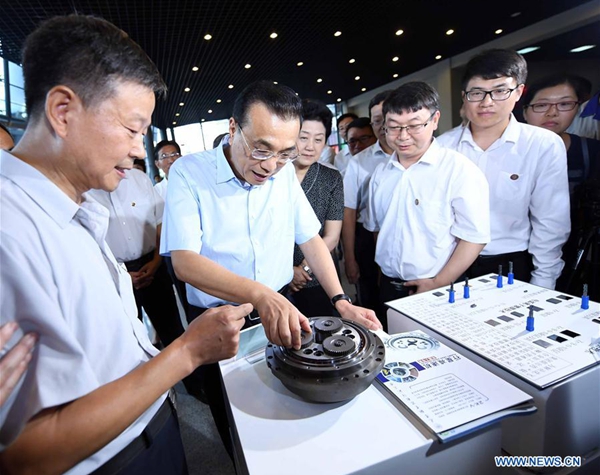China steps up building science and tech power
China has made a series of achievements in science and technology over the past month as the country quickens its pace in becoming a leading science and tech power by the middle of the century.
China has been a leader in quantum technologies, which eliminate the possibility of wiretapping and secure communication. In early September, it was announced the Beijing-Shanghai quantum communication network has met requirements to open for service.
The 2,000-km network, the world’s first, will be used for secure data transmission in the military, finance and government affairs fields.
The country has also completed a test of its high-throughput satellite Shijian-13, designating it as Zhongxing-16. With a transfer capacity of 20 Gbps, the satellite is capable of providing better Internet access on planes and high-speed trains, as well as in less-developed regions.
In a step toward launching a Mars probe around 2020, planners have mapped out a 400-million-yuan (61 million U.S. dollars) development plan to turn a red rock basin in Qaidam basin in northwest China’s Qinghai Province into a Mars scientific research base and eco-tourism site.
The base is expected to consist of a “Mars community” and a “Mars campsite.” The campsite will have a number of experimental module-like accommodations.
Underground research has also moved swiftly. Researchers recently acquired hot dry rock (HDR), with temperatures of 236 degrees Celsius, from 3,705 meters below Gonghe basin in Qinghai Province.
HDR is usually buried 3,000 to 10,000 meters under the earth’s surface. It can be used to generate clean electricity via its high temperatures. The breakthrough means China is a step closer to easing environmental problems related to the greenhouse effect and acid rain.
China has made innovation the core of its 13th five-year plan (2016-2020), with the aim of becoming an “innovation nation” by 2020, an international leader in innovation by 2030, and a world powerhouse in scientific and technological innovation by 2050.
“We will accelerate R&D and commercialization of new materials, artificial intelligence, integrated circuits, bio-pharmacy, 5G mobile communications, and other technology to develop industrial clusters in these fields,” said a government work report issued this year.
Such efforts will help the country improve convenience of transportation, raise living standards, resolve energy resource shortages, and boost economic development.
Developers said on Wednesday that track has been laid for China’s longest high-speed railway at high latitudes, and the railway is scheduled to open in June 2018.
Running at 200 km per hour, the 343-km railway linking Harbin, capital of the northeast province of Heilongjiang, and Jiamusi in the same province, runs through four tunnels and over 120 bridges. It will cut travel time to 1.5 hours from 7 hours.
On the environmental front, an in-orbit test of China’s first orbiting carbon observatory satellite was successfully completed in September. Scientists will convert magnetic signals received from the satellite into visible spectral signals, and then calculate the concentration of carbon dioxide.
While development of science and technology promises a better future, it also saves the lives of millions of people today.
According to a study published in late August, Chinese scientists have found a compound that helps a tumor-targeting virus kill liver cancer more effectively while sparing healthy cells, offering new hope for treating the world’s second most common cancer killer.
A therapy that uses viruses to selectively kill cancer cells is rapidly progressing through clinical evaluation, but the therapeutic efficacy in humans has been less than expected from pre-clinical studies, according to the study published in the U.S. journal Science Translational Medicine.
China needs science and technology more than ever and the country’s scientists should occupy the world’s science and technology high ground, said Bai Chunli, president of the Chinese Academy of Sciences (CAS).
The quickest and easiest way to achieve innovation is through a global cooperation network to boost innovation.
The G20 Blueprint on Innovative Growth, adopted at the Hangzhou summit in September last year, commits governments to creating a favorable environment for creativity and development.
Scientific innovation was also a central topic at the Belt and Road forum in Beijing in May, with China proposing a Belt and Road Science, Technology and Innovation Cooperation Action Plan.
A science and technology cooperation network along the Belt and Road will be completed in 2030, Bai said.
